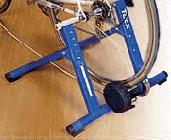Most cyclists find turbo training boring. This is often because many buy a turbo trainer to maintain or increase their training mileage when the weather is too bad to ride outdoors.
 Whilst the turbo can of course be used for this purpose, this form of extended use does tend to make turbo training boring. Consider other forms of training when the weather prevents you from going out on the bike, running is ideal, visits to the gym, or even 20-30 minutes spent stretching are certainly less boring than long sessions on the turbo. My own personnel record is 2½ hours that were instead of going on a Sunday morning ride due to 6" of snow on the ground. The following week with 3-4" of snow I went for a run for an hour instead and I enjoyed it more and it probably had a more beneficial effect.
Whilst the turbo can of course be used for this purpose, this form of extended use does tend to make turbo training boring. Consider other forms of training when the weather prevents you from going out on the bike, running is ideal, visits to the gym, or even 20-30 minutes spent stretching are certainly less boring than long sessions on the turbo. My own personnel record is 2½ hours that were instead of going on a Sunday morning ride due to 6" of snow on the ground. The following week with 3-4" of snow I went for a run for an hour instead and I enjoyed it more and it probably had a more beneficial effect.
Most cyclists seem to devise their own methods of trying to overcome the boredom: some watch television, others listen to a walkman, some read, but the best idea, in my view, is to find an alternative to riding a turbo for longer than an hour and to work on changing the tempo of the training during that hour. You'll see what we mean later.
The turbo really comes into its own when used in a planned and progressive training programme of interval training (aerobic or anaerobic). Efforts of varying intensity over pre-determined time periods are not boring - they can be hard or not so hard and require concentration to count pedal revs, check the times, monitor your heart rate etc. A 10 minute warm up followed by 6 x 5 minute "intervals" with 5 x 3 minute recovery periods, then 10 minutes cool down, gives a turbo session of 65 minutes and a good workout.
N.B. Intervals are essential to any training programme, and if carried out on the turbo the effort and duration are not only more controllable but also safer than on the road.
Equipment
Planning and preparation
Example sessions